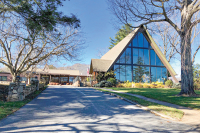NASA helps geologists try to understand WNC landslides
Mitigating the deadly and damaging effects of mountain landslides might be as simple as understanding them.
With that goal in mind, state geologists — in conjunction with National Aeronautics and Space Administration and a consortium of researchers — are launching a project that hopes to shed light on the inner workings of landslides. By this fall, scientists plan to have monitoring equipment buried at several mountainside sites in Western North Carolina. The equipment will transmit real-time data on what is going on under the surface to researchers in hopes that it will help them better understand what happens in the lead-up to a slope failure.
“The main idea is to advance or improve our ability to forecast when and where landslides will happen,” said Rick Wooten, senior geologist with the N.C. Geological Survey. The ability to accurately predict landslides could in turn save lives. “That’s the big picture,” Wooten said.
The half-acre sites chosen are places where landslides have happened in the past and where there is a high probability a landslide will occur in the future: bowl-shaped hollows perched high along the Blue Ridge Escarpment. Three of the four sites are in Macon County — one in Nantahala Forest and two at the Coweeta Hydrologic Laboratory, a government research area.
Macon County was an ideal location for researchers with its steep mountains, abundance of public lands and complete set of landslide hazard maps, which were created for the area in the wake of a deadly mudslide at Peeks Creek in 2004. The sites chosen are along the same ridge, the Blue Ridge Escarpment, that was the site of that natural disaster.
Related Items
“What we’re really interested in are these high elevation sites where debris flows typically start,” Wooten said. “What’s going on there?”
Several sensors will be buried at each site and scientists will sit back and collect data on weather, precipitation and ground saturation. The wetter the ground, the heavier and more likely it is to break away from the mountain and come tumbling down. Of course, there is no guarantee that a landslide will occur at one of the test locations during the span of the project. But if it did, experts would have a play-by-play of what was happening.
Regardless of whether the team of scientists hits the jackpot or not, Wooten said knowing what the mountainside can withstand without a landslide occurring is important as well.
“It’s a good starting point,” Wooten said.
The project is being funded by NASA, which will synthesize the underground data with satellite imaging of the region. Meanwhile, the University of Oklahoma will be focusing on the meteorology aspect of the project.









